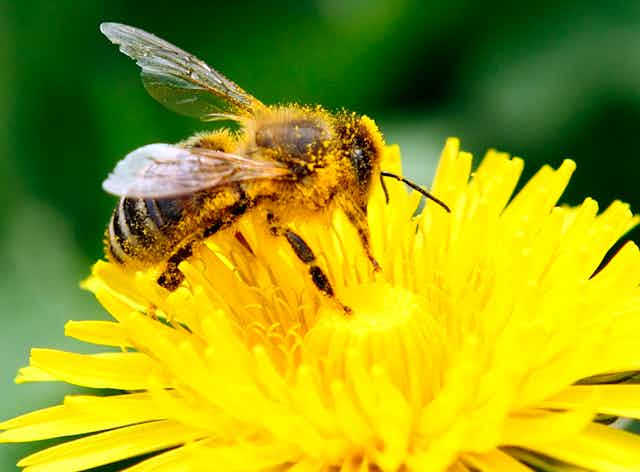We live in a world where large numbers of people are connected by just a few degrees of separation. But while having friends of friends all over the globe can be great for holidays, trade and networking, travel also allows viruses to move like never before.
Zika is the latest “explosive pandemic” to be declared a global emergency by the World Health Organisation. But viruses don’t just target humans – they can infect all forms of life from bacteria to bananas, horses to honeybees.
A lethal combination of the Varroa mite and the deformed wing virus has resulted in the death of billions of bees over the past half century. In a study published in the journal Science, colleagues from the Universities of Exeter, Sheffield and I report how the virus has spread across the globe.
Bee boundaries
Honeybees are geographically separated into two distinct groups, a single species from Africa, confusingly known as the European honeybee, and six other species, all from Asia. The European honeybee is the main species managed by humans, purely because of its ability to make the most honey per colony.
In the 1950s these European bees were taken to Asia to improve honey production, and at some point the Varroa mite jumped the species barrier from its native Asian honeybee across to the Western one. Over the next 50 years, the mites spread around the world with the global trade in European honeybees.

Within three to five years of the mites’ arrival, bee colonies started to collapse on a massive scale. Natural wild populations were soon wiped out, as were millions of managed colonies.
A crippling death
For decades it was thought that bees were being sucked to death by the mites, as the mites feed exclusively on the bees’ blood. This idea was supported by the appearance of bees in heavily-infested colonies with dry, crippled wings.
But more recent research showed that the Varroa mite was, in fact, a carrier rather than a killer, transmitting deformed wing virus directly into the bloodstream. Though bees suffer from various viruses, these are usually found at very low levels and move between bees via food or during mating. The Varroa mite’s totally new transmission route changed the game.
Some infected honeybees had crippled wings so could not fly and died quickly, but although most infected bees had normal wings their lifespan was shortened by up to 50% by the virus – causing inevitable colony collapse.

Over time, the virus evolved into a single killer form, now known as the A-type, and it is this which has since spread to bee colonies globally. By analysing data from bees and mites collected around the world, the evolutionary history of this pathogen was reconstructed to reflect how it was spreading.
Future flight
We learned that the deformed wing virus originated within European honeybees themselves, and not their Asian relatives or the mites. The Varroa mite just happened to be particularly effective at spreading the virus.
The current pandemic started in the mid-20th century and its spread mirrors that of the Varroa mite. European and North American honeybee colonies were found to be the main transmission hubs, which is to be expected since they are key areas in the global bee trade.

Honeybees and other pollinators are all interconnected via trade, which creates an ideal situation for the rapid spread of pathogens and parasites worldwide and between species – including bumblebees.
There are many parallels between the global spread of deformed wing virus and other insect-borne human pathogens such as the Zika virus. And as international trade and travel continues to increase we can expect to see many more emerging viruses impacting both human and animal health.
But our genetic history indicates we are well adapted to survive these emerging pathogens, and there are a number of Varroa infested honeybee populations around the world that can now survive without any form of mite control. Natural selection wins again it would seem.

